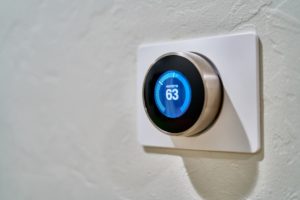
Looking to cut costs from the monthly budget? Knowing how to save on the electric bill is a good start. Whether it’s running big appliances too often or unnecessarily or simply leaving the thermostat turned up when no one is home, there are ways to trim your energy consumption in your house or apartment that could cut your electric bill in half, saving hundreds of dollars a year. To get started, here are 10 tips to save big on your electric bill:
Programmable Thermostat
Installing a programmable thermostat allows you to efficiently maintain the temperature in your home throughout the day. Depending on the season, letting your heat or AC run all day when no one is home is a waste of energy and can increase your electric bill. Programming your thermostat to adjust to certain times of day when you’re home or away can lead to savings.
Use A Smart Power Strip
Plug your electric devices into a smart power strip and save. Whenever an appliance or any electronic device is plugged in it is still drawing power—even when it’s shut off. A coffee maker, toaster, an oven, the HDTV—when you’re in bed or at work, they’re using electricity and costing you money. A smart power strip turns off the power to selected devices when they are not in use.
Use Energy Efficient Light Bulbs
Every watt counts. Change out your old light bulbs and replace them with energy-efficient ones. Old light bulbs may cost a little less to purchase, but they use more energy and will cost you more at the end of each month. Besides saving on your electric bill, energy-efficient light bulbs have the added benefit of lasting longer and shining brighter. To save money, start by changing a few bulbs at a time over the course of several months.
Change Your Air Filters Regularly
A dirty air filter means your air handler has to run longer to circulate air through your house or apartment. When the air handler’s running, it’s drawing more power and raising your electric bill. Change your air filter each month and make sure it is the correct size for the frame.
Use Cold Water to Wash Clothes
Heating water consumes energy. Save it for the shower only and start washing your clothes in cold water. Every time you fill the water tank back up to heat it costs you money. Switching to cold water to wash your clothes means using less energy to heat your water tank and will help lower your electric bill.
Air Dry Your Laundry
Rather than using an electric dryer to dry your clothes, consider hang drying them and save big. Your dryer and refrigerator are the two most energy-consuming appliances in your home. Switching to retractable clothes drying rack is easy and inexpensive. Winter, summer, rain or shine, you can place the rack anywhere inside or out to let your clothes dry.
Wash Your Dishes
Instead of loading up the dishwasher for a nightly cycle, consider cleaning your dirty dishes the old fashion way—by hand—at least a few nights a week. Dishwashers require considerable energy to operate. They use lots of hot water and then must generate heat to dry the dishes, both of which consume energy that adds dollars to your monthly electric bill.
Switch to Fans Instead of Maxing Out the AC
Keeping your home cool and comfy during the summer months can get expensive if you’re running the AC all day. Set your thermostat at 72 degrees and turn on a fan—portable or ceiling—to cool your home. You save because fans use less energy to run than the air conditioner.
Dress for the Season
It may be comfortable to turn the thermostat up to 78 degrees in January and slip into shorts and a t-shirt, but it will cost you. To help lower your electric bill, lower your thermostat to 68 and wear sweatpants and a hoodie to stay warm and comfy around the house.
Seal Your Windows
Whether summer or winter, cool or warm air can easily slip out your windows if they are not properly sealed. Insulating your windows or installing insulated windows can help save money on your electric bill. Caulk any cracks around the frame and be sure to hang drapes or curtains, too.
Need some cash quick? My Tio Rico Te Ayuda can help, we offer two types of loans that can help you get back on your feet.

